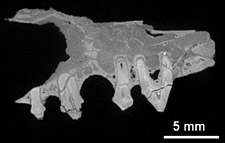
Image obtained by the new microscope of viverravus acutus, a small meat-eating mammal that lived around 50 million years agoA unique 3-dimensional microscope that works in a new way is giving unprecedented insight into microscopic internal structure and chemical composition. It is revealing how materials are affected, over time, by changes in temperature, humidity, weight load and other conditions.
The device could lead to advances in a range of areas, such as healthcare (in furthering, for instance, the understanding of conditions such as osteoporosis), the development of better construction materials, improved oil extraction methods and even the study of fossils.
Like a number of other microscopes, the new microscope harnesses X-rays to provide information about an object's internal structure down to micron scale. (A micron is a millionth of a metre.) What makes it unique, however, is its innovative use of a technique called 'time delay integration', which enables it to generate much better images of larger objects than any other device. This means that microscopic structure can be studied with greater accuracy.
With EPSRC funding, a multi-disciplinary team drawn from six UK universities has been developing and utilising the microscope, which, although similar to the CT scanners used in healthcare, can view things in much greater detail.
X-ray microscopes can produce 3-d internal pictures of an object by taking a large number of 2-d images from different angles – this is known as X-ray microtomography. However, the new microscope's combining of this technique with time delay integration is completely unique. Through averaging out imperfections in the image across all pixels, this approach enables the microscope to produce clearer and bigger pictures than previously possible (see 'Notes for Editors').
Some of the microscope's many potential uses include:
- Studying how bone and tooth tissue behave in conditions such as osteoporosis, osteoarthritis and tooth decay. By improving understanding of these conditions, the microscope could aid prevention, earlier diagnosis and more effective treatment.
- Observing how crude oil is held in sandstone pores. This knowledge could assist the development of more efficient ways of exploiting both offshore and onshore oil resources.
- Investigating the mechanical behaviour of metals at a microscopic level. This could contribute to development of more reliable, more resilient and lower weight materials for use in construction, aviation and the storage & transportation of dangerous substances.
- Detailed study of fossils embedded in rocks without having to remove and risk damaging them.
Professor Jim Elliott of Queen Mary, University of London led the project. "As well as developing these microscopes to study subtle variations in internal structure, a main aim of ours is to work with the wider scientific community to identify problems where they could make a real contribution," he says. "There's no limit to what it would be useful or interesting to look at."
The microscope looks set to be a valuable research tool that many different organisations in a wide range of sectors could benefit from using. The team is currently planning to seek funding to support the development of a radical new design that could be even more effective.
Notes for Editors
The three and a half year research project "Support and Enhancement for X-Ray Microtomography Facility for Study of Bone, Tooth and Engineering Materials" received EPSRC funding of just over £154,000.
The project involved experts in electronic engineering, physics, biophysics, chemistry, anatomy, materials science, dentistry, veterinary medicine and engineering from:
- Queen Mary, University of London
- Cranfield University
- Imperial College London
- The Royal Veterinary College
- The University of Manchester
- The University of Southampton
In X-ray microtomography, there are variations in the sensitivity of the pixels that make up the picture captured by the sensor. These feed into the final computer-generated 3-d image, making it less clear. In the new microscope, a method called time delay integration is used whereby the camera incorporating the sensor is moved through the X-ray shadow whilst collecting the X-ray image. At the same time, the image being created on the surface of the sensor is electronically shifted in the opposite direction. In this way, any imperfections are 'smoothed out' by averaging them over all pixels before the 3-d image is generated. The final image is thus of much higher quality. The use of time delay integration also allows larger objects to be examined without loss of image quality. The new microscope is the only one in the world that uses time delay integration for microtomography.
Osteoporosis is a disease in which bones become highly porous and tend both to break easily and heal slowly.
Osteoarthritis is a type of arthritis where there is a gradual loss of cartilage tissue in joints.
The Engineering and Physical Sciences Research Council (EPSRC) is the UK's main agency for funding research in engineering and the physical sciences. The EPSRC invests more than £500 million a year in research and postgraduate training, to help the nation handle the next generation of technological change. The areas covered range from information technology to structural engineering, and mathematics to materials science. This research forms the basis for future economic development in the UK and improvements for everyone's health, lifestyle and culture. EPSRC also actively promotes public awareness of science and engineering. EPSRC works alongside other Research Councils with responsibility for other areas of research. The Research Councils work collectively on issues of common concern via Research Councils UK. Website address for more information on EPSRC: www.epsrc.ac.uk/
Source : Engineering and Physical Sciences Research Council
 Print Article
Print Article Mail to a Friend
Mail to a Friend
